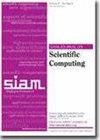Slow Invariant Manifolds of Singularly Perturbed Systems via Physics-Informed Machine Learning
IF 2.6
2区 数学
Q1 MATHEMATICS, APPLIED
引用次数: 0
Abstract
SIAM Journal on Scientific Computing, Volume 46, Issue 4, Page C297-C322, August 2024.Abstract. We present a physics-informed machine learning (PIML) approach for the approximation of slow invariant manifolds of singularly perturbed systems, providing functionals in an explicit form that facilitates the construction and numerical integration of reduced-order models (ROMs). The proposed scheme solves the partial differential equation corresponding to the invariance equation (IE) within the geometric singular perturbation theory (GSPT) framework. For the solution of the IE, we used two neural network structures, namely, feedforward neural networks and random projection neural networks, with symbolic differentiation for the computation of the gradients required for the learning process. The efficiency of our PIML method is assessed via three benchmark problems, namely, the Michaelis–Menten, the target-mediated drug disposition reaction mechanism, and the 3D Sel’kov model. We show that the proposed PIML scheme provides approximations of equivalent or even higher accuracy than those provided by other traditional GSPT-based methods, and importantly, for any practical purposes, it is not affected by the magnitude of the perturbation parameter. This is of particular importance because there are many systems for which the gap between the fast and slow timescales is not that big, but still, ROMs can be constructed. A comparison of the computational costs between symbolic, automatic, and numerical approximation of the required derivatives in the learning process is also provided. Reproducibility of computational results. This paper has been awarded the “SIAM Reproducibility Badge: Code and data available” as a recognition that the authors have followed reproducibility principles valued by SISC and the scientific computing community. Code and data that allow readers to reproduce the results in this paper are available at https://epubs.siam.org/doi/suppl/10.1137/23M1602991/suppl_file/131735_1_supp_551502_s5k7wy_sc.pdf and https://epubs.siam.org/doi/suppl/10.1137/23M1602991/suppl_file/SISC_PIML_SIMs_SP-main.zip.
通过物理学启发的机器学习研究奇异扰动系统的慢速不变频域
SIAM 科学计算期刊》,第 46 卷第 4 期,第 C297-C322 页,2024 年 8 月。 摘要我们提出了一种物理信息机器学习(PIML)方法,用于逼近奇异扰动系统的慢速不变流形,以显式形式提供函数,从而方便构建和数值积分降阶模型(ROM)。所提出的方案在几何奇异扰动理论(GSPT)框架内求解与不变性方程(IE)相对应的偏微分方程。为了求解 IE,我们使用了两种神经网络结构,即前馈神经网络和随机投影神经网络,并使用符号微分来计算学习过程所需的梯度。我们通过三个基准问题评估了 PIML 方法的效率,这三个基准问题分别是 Michaelis-Menten、靶点介导的药物处置反应机制和三维 Sel'kov 模型。我们发现,所提出的 PIML 方案提供的近似精度与其他基于 GSPT 的传统方法相当,甚至更高,而且重要的是,在任何实际应用中,它都不受扰动参数大小的影响。这一点尤为重要,因为对于许多系统来说,快慢时标之间的差距并不大,但仍然可以构建 ROM。我们还对学习过程中所需导数的符号逼近、自动逼近和数值逼近的计算成本进行了比较。计算结果的可重复性。本文被授予 "SIAM 可重现徽章":代码和数据可用",以表彰作者遵循了 SISC 和科学计算界重视的可重现性原则。读者可通过 https://epubs.siam.org/doi/suppl/10.1137/23M1602991/suppl_file/131735_1_supp_551502_s5k7wy_sc.pdf 和 https://epubs.siam.org/doi/suppl/10.1137/23M1602991/suppl_file/SISC_PIML_SIMs_SP-main.zip 获取代码和数据,以重现本文中的结果。
本文章由计算机程序翻译,如有差异,请以英文原文为准。
求助全文
约1分钟内获得全文
求助全文
来源期刊
CiteScore
5.50
自引率
3.20%
发文量
209
审稿时长
1 months
期刊介绍:
The purpose of SIAM Journal on Scientific Computing (SISC) is to advance computational methods for solving scientific and engineering problems.
SISC papers are classified into three categories:
1. Methods and Algorithms for Scientific Computing: Papers in this category may include theoretical analysis, provided that the relevance to applications in science and engineering is demonstrated. They should contain meaningful computational results and theoretical results or strong heuristics supporting the performance of new algorithms.
2. Computational Methods in Science and Engineering: Papers in this section will typically describe novel methodologies for solving a specific problem in computational science or engineering. They should contain enough information about the application to orient other computational scientists but should omit details of interest mainly to the applications specialist.
3. Software and High-Performance Computing: Papers in this category should concern the novel design and development of computational methods and high-quality software, parallel algorithms, high-performance computing issues, new architectures, data analysis, or visualization. The primary focus should be on computational methods that have potentially large impact for an important class of scientific or engineering problems.

 求助内容:
求助内容: 应助结果提醒方式:
应助结果提醒方式:


